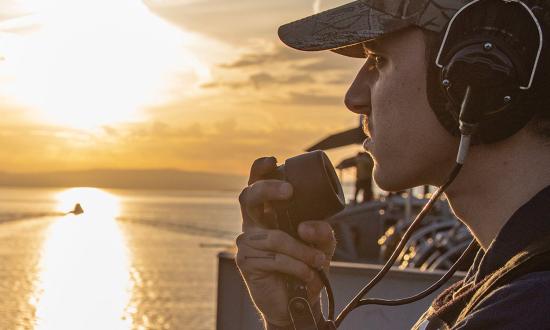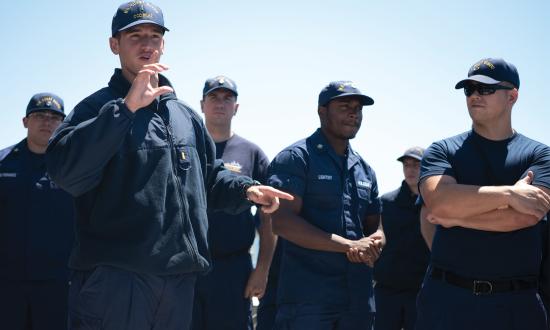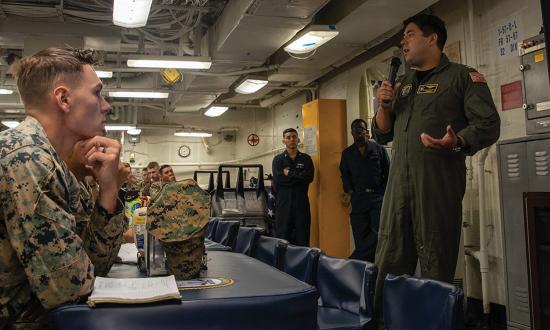Serving in the Navy comes with great rewards but also can entail sacrifice. Sailors devote innumerable hours standing duty; on workups, training detachments, and temporary assigned duties; and on long deployments at sea and abroad. The nature of the profession involves physical risk and places stress on sailors and their families.
During critical evolutions, the mission must take precedence. Despite instructions and risk management procedures, equipment continues to be damaged and sailors sometimes get hurt. In addition, poor decision-making off duty can lead to people getting injured. Two things can address these mishaps and improve the wellbeing of the nation’s sea warriors. With an increased focus on leadership training and sailor engagement, U.S. Navy personnel will be safer at home and in
the fleet.
Leadership
Simply holding a leadership position does not make someone a good leader. For many people, demanding obedience comes more naturally than commanding respect. Consider the coach of an athletic team. A good coach is willing to drop down to a knee to connect with their players and never has to remind anyone that he or she is the coach. In addition to being ineffective, a coach who constantly needs to remind his or her players of this lacks “knee down” leadership and has likely already lost the team’s support. A good coach has proven his or her ability and therefore has earned the respect and trust of the team.
When a service member is assigned an unfamiliar task with limited training, there can be a risk of injury, damage to equipment, or the task being done incorrectly or incompletely. Failure to correctly complete a task could put the mission or personnel in jeopardy. Leaders should be encouraged to “drop down to a knee” and physically demonstrate how to accomplish the task. This not only provides sailors clarity about the task at hand, but also develops crucial respect and trust within the team.
A supervisor shared a story with me emphasizing this point. A weapons magazine needed to be refurbished while a ship was in the shipyard. As a new leading petty officer (LPO), he was assigned to the division responsible for the job. The division had been tasked repeatedly by the previous LPO, but the work was inadequate. One day, the new LPO buzzed around the ship acquiring air hoses, needle guns, and all the other tools required to accomplish the task. Then, while the division observed, the new LPO began to grind and chip. The junior sailors slowly began to engage. Once properly instructed on how to assemble the hoses and gear, everyone began to grind with their now dust- and paint-covered LPO. The extra effort paid dividends. The job was done effectively and quickly. The LPO motivated the division, ensured the job was completed properly, and reduced the risk of injury to personnel and damage to equipment.
Engagement
Finally, sailors must be engaged. Accidents happen when a member of a team is not invested in the mission. Whether on a ship, on the ground, or in the air, service members need to believe in their role. Sometimes in a command, a large percentage of labor and responsibility falls on a small percentage of the crew. This leaves some team members inactive while others are overextended. This should not be the norm. Everyone has a role to fill, and it is imperative that all team members are held accountable. With responsibility comes pride, and with pride comes vigilance. The more mentally and physically immersed sailors are in their assignments, the more likely they are to minimize errors and reduce risk.
Engagement can be encouraged in multiple ways. Group physical training, team-building activities, command-wide intramural sports, and interdivisional competitions are examples of non-work-related activities that can stimulate engagement. On a personal note, I take pride in the space I am assigned to clean every day. Two shipmates and I maintain the self-proclaimed cleanest head on the ship. We are still waiting for another division to challenge our title. This is a perhaps menial but prime opportunity for sailors to demonstrate responsibility.
What makes the Sea Services so effective is their ability to mobilize and operate anywhere in the world. The Navy is among the most highly functioning organizations in the world, but with this incredible amount of man and machine power comes risk. However, with additional focus on enhancing leadership practices, strengthening physical readiness, and striving to better engage individual sailors, the Navy can continue to reduce these risks and become more capable in the fight to come.
Looking Forward
During my time in the Navy, I have witnessed the positive effects of new policies. Sailors have directly benefited from more extensive medical training such as the Tactical Combat Casualty Care course, schedule adjustments adhering to circadian rhythm studies, nutritional variety, and education on the physiological effects of excessive screen time, etc. The Navy is moving in the right direction. Although some systems are not perfect, I am confident they will continue to improve. With a focus on leadership and personal engagement, the Navy will continue to develop and grow as the greatest warfighting organization in the world.








